Network Structure and Properties of Lithium Aluminosilicate Glass
Abstract
:1. Introduction
2. Materials and Methods
2.1. Glass Preparation and Characterization
2.2. Glass Testing and Characterization
3. Results
3.1. Structural Analysis
3.1.1. 27Al NMR Analysis
3.1.2. 11B NMR Analysis
3.1.3. 29Si NMR Analysis
3.1.4. Raman Spectroscopy
4. Discussion
4.1. Summary of the NMR and Raman Observations
4.2. Effect of Network Structure on Performance
4.2.1. Thermal Expansion Analysis
4.2.2. Microhardness
4.2.3. Physical Properties
4.2.4. Chemical Stability
5. Conclusions
Author Contributions
Funding
Data Availability Statement
Acknowledgments
Conflicts of Interest
References
- Shan, Z.; Zhang, Y.; Liu, S.; Tao, H.; Yue, Y. Mixed-alkali effect on hardness and indentation-loading behavior of a borate glass system. J. Non-Cryst. Solids 2020, 548, 120314. [Google Scholar] [CrossRef]
- Schaut, R.A. The Effect of Boron Oxide on the Composition, Structure, and Adsorptivity of Glass Surfaces. Ph.D. Thesis, Pennsylvania State University, State College, PA, USA, 2008. [Google Scholar]
- Choi, S.H.; Na Ko, Y.; Kim, J.H.; Hong, Y.J.; Kang, Y.C. Characteristics of BaO–B2O3–SiO2 nano glass powders prepared by flame spray pyrolysis as the sintering agent of BaTiO3 ceramics. J. Alloy. Compd. 2011, 509, 7979–7984. [Google Scholar] [CrossRef]
- Sun, T.; Xiao, H.; Guo, W.; Hong, X. Effect of Al2O3 content on BaO–Al2O3–B2O3–SiO2 glass sealant for solid oxide fuel cell. Ceram. Int. 2010, 36, 821–826. [Google Scholar] [CrossRef]
- Derno, M.; Herms, G.; Steil, H. X-ray Study on the Boron Coordination in Sodium Borate Glasses at Higher Temperatures. Phys. Status Solidi (A) 1986, 93, K5–K8. [Google Scholar] [CrossRef]
- Lu, X.; Deng, L.; Huntley, C.; Ren, M.; Kuo, P.-H.; Thomas, T.; Chen, J.; Du, J. Mixed Network Former Effect on Structure, Physical Properties, and Bioactivity of 45S5 Bioactive Glasses: An Integrated Experimental and Molecular Dynamics Simulation Study. J. Phys. Chem. B 2018, 122, 2564–2577. [Google Scholar] [CrossRef]
- Lu, X.; Deng, L.; Du, J.; Vienna, J.D. Predicting boron coordination in multicomponent borate and borosilicate glasses using analytical models and machine learning. J. Non-Cryst. Solids 2020, 553, 120490. [Google Scholar] [CrossRef]
- Yiannopoulos, Y.D.; Chryssikos, G.D.; Kamitsos, E.I. Structure and properties of alkaline earth borate glasses. Phys. Chem. Glasses 2001, 42, 164–172. [Google Scholar]
- Wright, A.C.; Dalba, G.; Rocca, F.; Vedishcheva, N.M. Borate versus silicate glasses: Why are they so different? Phys. Chem. Glasses-Eur. J. Glass Sci. Technol. Part B 2010, 51, 233–265. [Google Scholar]
- Ghoneim, N.; Abbas, A. Thermal expansion of high lead borate glasses and the boric oxide anomaly. Thermochim. Acta 1993, 66, 91–103. [Google Scholar] [CrossRef]
- Roderick, J.; Holland, D.; Howes, A.; Scales, C. Density–structure relations in mixed-alkali borosilicate glasses by 29Si and 11B MAS–NMR. J. Non-Cryst. Solids 2001, 293–295, 746–751. [Google Scholar] [CrossRef]
- Bubnova, R.; Levin, A.A.; Stepanov, N.K.; Belger, A.; Meyer, D.C.; Polyakova, I.G.; Filatov, S.; Paufler, P. Crystal structure of K1-xCsxBSi2O6 (x = 0.12, 0.50) boroleucite solid solutions and thermal behaviour of KBSi2O6 and K0.5Cs0.5BSi2O6. Z. Für Krist.-Cryst. Mater. 2002, 217, 55–62. [Google Scholar] [CrossRef]
- Betzen, A.R.; Kudlacek, B.L.; Kapoor, S.; Berryman, J.R.; Lower, N.P.; Feller, H.A.; Affatigato, M.; Feller, S.A. Physical properties of barium borosilicate glasses related to atomic structure. Phys. Chem. Glasses 2003, 44, 207–211. [Google Scholar]
- Levitskii, I.A.; Gailevich, S.A.; Shimchik, I.S. The Effect of Bivalent Cations on the Physicochemical Properties and Structure of Borosilicate Glasses. Glas. Ceram. 2004, 61, 73–76. [Google Scholar] [CrossRef]
- Protasova, L.G.; Kosenko, V.G. Effect of Additives on the Structure and Physicochemical Properties of Sodium-Borosilicate Glasses. Glas. Ceram. 2003, 60, 164–165. [Google Scholar] [CrossRef]
- Bobkova, N.M. Thermal Expansion of Binary Borate Glasses and Their Structure. Glas. Phys. Chem. 2003, 29, 501–507. [Google Scholar] [CrossRef]
- Yun, Y.; Bray, P. Nuclear magnetic resonance studies of the glasses in the system Na2O-B2O3-SiO2. J. Non-Cryst. Solids 1978, 27, 363–380. [Google Scholar] [CrossRef]
- Stebbins, J.F.; Zhao, P.; Kroeker, S. Non-bridging oxygens in borate glasses: Characterization by 11B and 17O MAS and 3QMAS NMR. Solid State Nucl. Magn. Reson. 2000, 16, 9–19. [Google Scholar] [CrossRef]
- Du, L.-S.; Stebbins, J.F. Network connectivity in aluminoborosilicate glasses: A high-resolution 11B, 27Al and 17O NMR study. J. Non-Cryst. Solids 2005, 351, 3508–3520. [Google Scholar] [CrossRef]
- Dell, W.; Bray, P.; Xiao, S. 11B NMR studies and structural modeling of Na2O-B2O3-SiO2 glasses of high soda content. J. Non-Cryst. Solids 1983, 58, 1–16. [Google Scholar] [CrossRef]
- El-Moneim, A.A.; Youssof, I.; El-Latif, L.A. Structural role of RO and Al2O3 in borate glasses using an ultrasonic technique. Acta Mater. 2006, 54, 3811–3819. [Google Scholar] [CrossRef]
- Xie, J.; Tang, H.; Wang, J.; Wu, M.; Han, J.; Liu, C. Network connectivity and properties of non-alkali aluminoborosilicate glasses. J. Non-Cryst. Solids 2018, 481, 403–408. [Google Scholar] [CrossRef]
- Cormier, L.; de Sousa Meneses, D.; Neuville, D.R.; Echegut, P. In situ evolution of the structure of alkali borate glasses and melts by infrared reflectance and Raman spectroscopies. Phys. Chem. Glasses Eur. J. Glass Sci. Technol. B 2006, 47, 430–434. [Google Scholar]
- Mysen, B.O.; Virgo, D.; Seifert, F.A. The structure of silicate melts: Implications for chemical and physical properties of natural magma. Rev. Geophys. 1982, 20, 353–383. [Google Scholar] [CrossRef]
- Matson, D.W.; Sharma, S.K.; Philpotts, J.A. The structure of high-silica alkali-silicate glasses. A Raman spectroscopic investigation. J. Non-Cryst. Solids 1983, 58, 323–352. [Google Scholar] [CrossRef]
- Merzbacher, C.I.; White, W.B. The structure of alkaline earth aluminosilicate glasses as determined by vibrational spectroscopy. J. Non-Cryst. Solids 1991, 130, 18–34. [Google Scholar] [CrossRef]
- Neuville, D.R.; Cormier, L.; Massiot, D. Al environment in tectosilicate and peraluminous glasses: A 27Al MQ-MAS NMR, Raman, and XANES investigation. Geochim. Cosmochim. Acta 2004, 68, 5071–5079. [Google Scholar] [CrossRef]
- Malfait, W.; Zakaznova-Herzog, V.; Halter, W. Quantitative Raman spectroscopy: High-temperature speciation of potassium silicate melts. J. Non-Cryst. Solids 2007, 353, 4029–4042. [Google Scholar] [CrossRef]
- Morizet, Y.; Paris, M.; Gaillard, F.; Scaillet, B. Carbon dioxide in silica-undersaturated melt Part II: Effect of CO2 on quenched glass structure. Geochim. Cosmochim. Acta 2014, 144, 202–216. [Google Scholar] [CrossRef]
- Morizet, Y.; Vuilleumier, R.; Paris, M. A NMR and molecular dynamics study of CO2-bearing basaltic melts and glasses. Chem. Geol. 2015, 418, 89–103. [Google Scholar] [CrossRef] [Green Version]
- Manara, D.; Grandjean, A.; Neuville, D.R. In situ evolution of the structure of alkali borate glasses and melts by infrared reflectance and Raman spectroscopies. Am. Mineral. 2009, 94, 777–784. [Google Scholar] [CrossRef]
- Yadav, A.K.; Singh, P. A review of the structures of oxide glasses by Raman spectroscopy. RSC Adv. 2015, 5, 67583–67609. [Google Scholar] [CrossRef]
- Bunker, B.C.; Tallant, D.R.; Kirkpatrick, R.J.; Turner, G.L. Nuclear magnetic resonance and Raman investigation of sodium borosilicate glass structures. Phys. Chem. Glasses 1990, 31, 30–41. [Google Scholar]
- Wang, Z.; Cheng, L. Structural evolution of CeO2-doped alkali boroaluminosilicate glass and the correlation with physical properties based on a revised structural parameter analysis. RSC Adv. 2016, 6, 5456–5465. [Google Scholar] [CrossRef]
- Konijnendijk, W.; Stevels, J. The structure of borate glasses studied by Raman scattering. J. Non-Cryst. Solids 1975, 18, 307–331. [Google Scholar] [CrossRef]
- Meera, B.; Sood, A.; Chandrabhas, N.; Ramakrishna, J. Raman study of lead borate glasses. J. Non-Cryst. Solids 1990, 126, 224–230. [Google Scholar] [CrossRef]
- Yano, T.; Kunimine, N.; Shibata, S.; Yamane, M. Structural investigation of sodium borate glasses and melts by Raman spectroscopy. III. Relation between the rearrangement of super-structures and the properties of glass. J. Non-Cryst. Solids 2003, 321, 157–168. [Google Scholar] [CrossRef]
- Zhong, J.; Bray, P. Change in boron coordination in alkali borate glasses, and mixed alkali effects, as elucidated by NMR. J. Non-Cryst. Solids 1989, 111, 67–76. [Google Scholar] [CrossRef]
- Yun, Y.; Bray, P. B11 nuclear magnetic resonance studies of Li2O-B2O3 glasses of high Li2O content. J. Non-Cryst. Solids 1981, 44, 227–237. [Google Scholar] [CrossRef]
- Vidal, L.; Joussein, E.; Colas, M.; Cornette, J.; Sanz, J.; Sobrados, M.I.; Gelet, J.-L.; Absi, J.; Rossignol, S. Controlling the reactivity of silicate solutions: A FTIR, Raman and NMR study. Colloids Surf. A Physicochem. Eng. Asp. 2016, 503, 101–109. [Google Scholar] [CrossRef]
- Mabrouk, A.; Vaills, Y.; Pellerin, N.; Bachar, A. Structural study of lanthanum sodium aluminoborosilicate glasses by NMR spectroscopy. Mater. Chem. Phys. 2020, 254, 123492. [Google Scholar] [CrossRef]
- Kusumoto, H.; Hill, R.G.; Karpukhina, N.; Law, R.V. Magnesium substitution in calcium and strontium fluoro-phospho-aluminosilicate glasses by multinuclear 19F, 31P, 27Al, and 29Si MAS-NMR spectroscopy. J. Non-Cryst. Solids X 2019, 1, 100008. [Google Scholar] [CrossRef]
- Dupuy, C.; Gharzouni, A.; Sobrados, I.; Texier-Mandoki, N.; Bourbon, X.; Rossignol, S. 29Si, 27Al, 31P and 11B magic angle spinning nuclear magnetic resonance study of the structural evolutions induced by the use of phosphor- and boron–based additives in geopolymer mixtures. J. Non-Cryst. Solids 2019, 521, 119541. [Google Scholar] [CrossRef]
- Prasad, S.; Clark, T.M.; Sefzik, T.H.; Kwak, H.-T.; Gan, Z.; Grandinetti, P.J. Solid-state multinuclear magnetic resonance investigation of Pyrex®. J. Non-Cryst. Solids 2006, 352, 2834–2840. [Google Scholar] [CrossRef]
- Engelhardt, G.; Michel, D. High-Resolution Solid-State NMR of Silicates and Zeolites; John Wiley & Sons: New York, NY, USA, 1987. [Google Scholar]
- Prasad, K.; Suman, C.K.; Choudhary, R.N.P. Thermal history of a low alkali borosilicate glass probed by infrared and Raman spectroscopy. Eur. J. Glass Sci. Technol. Part A Glass Technol. 2006, 47, 133–137. [Google Scholar] [CrossRef]
- Osipov, A.A.; Eremyashev, V.E.; Mazur, A.S.; Tolstoi, P.M.; Osipova, L. Coordination state of aluminum and boron in barium aluminoborate glass. Glas. Phys. Chem. 2016, 42, 230–237. [Google Scholar] [CrossRef]
- Morin, E.I.; Stebbins, J.F. Separating the effects of composition and fictive temperature on Al and B coordination in Ca, La, Y aluminosilicate, aluminoborosilicate and aluminoborate glasses. J. Non-Cryst. Solids 2016, 432, 384–392. [Google Scholar] [CrossRef] [Green Version]
- Morin, E.I.; Wu, J.; Stebbins, J.F. Modifier cation (Ba, Ca, La, Y) field strength effects on aluminum and boron coordination in aluminoborosilicate glasses: The roles of fictive temperature and boron content. Appl. Phys. A 2014, 116, 479–490. [Google Scholar] [CrossRef]
- Engelhardt, G. 29Si MAS NMR of Zeolites: Semi-empirical interpretation of chemical shifts and their relation to structure parameters. Stud. Surf. Sci. Catal. 1989, 52, 151–162. [Google Scholar] [CrossRef]
- Lee, S.K.; Stebbins, J.F. Al–O–Al and Si–O–Si sites in framework aluminosilicate glasses with Si/Al=1: Quantification of framework disorder. J. Non-Cryst. Solids 2000, 270, 260–264. [Google Scholar] [CrossRef]
- Huang, Q.; Liu, J.; He, X.; Liu, T.; Lu, A. Analysis of structure evolution and performance in alkali-free glass substrates via XPS and infrared: Boron-aluminum anomaly. J. Non-Cryst. Solids 2020, 555, 120531. [Google Scholar] [CrossRef]

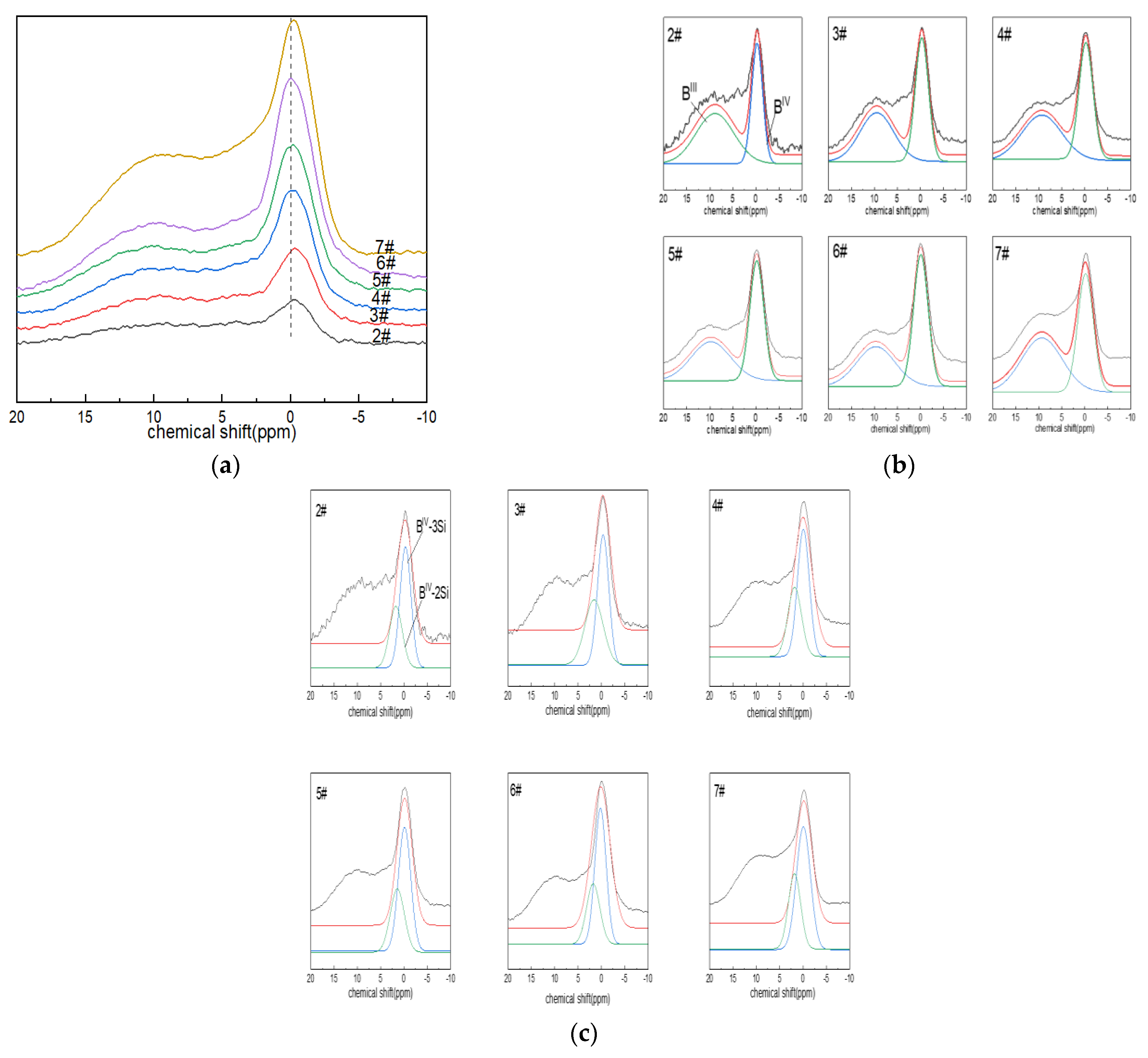
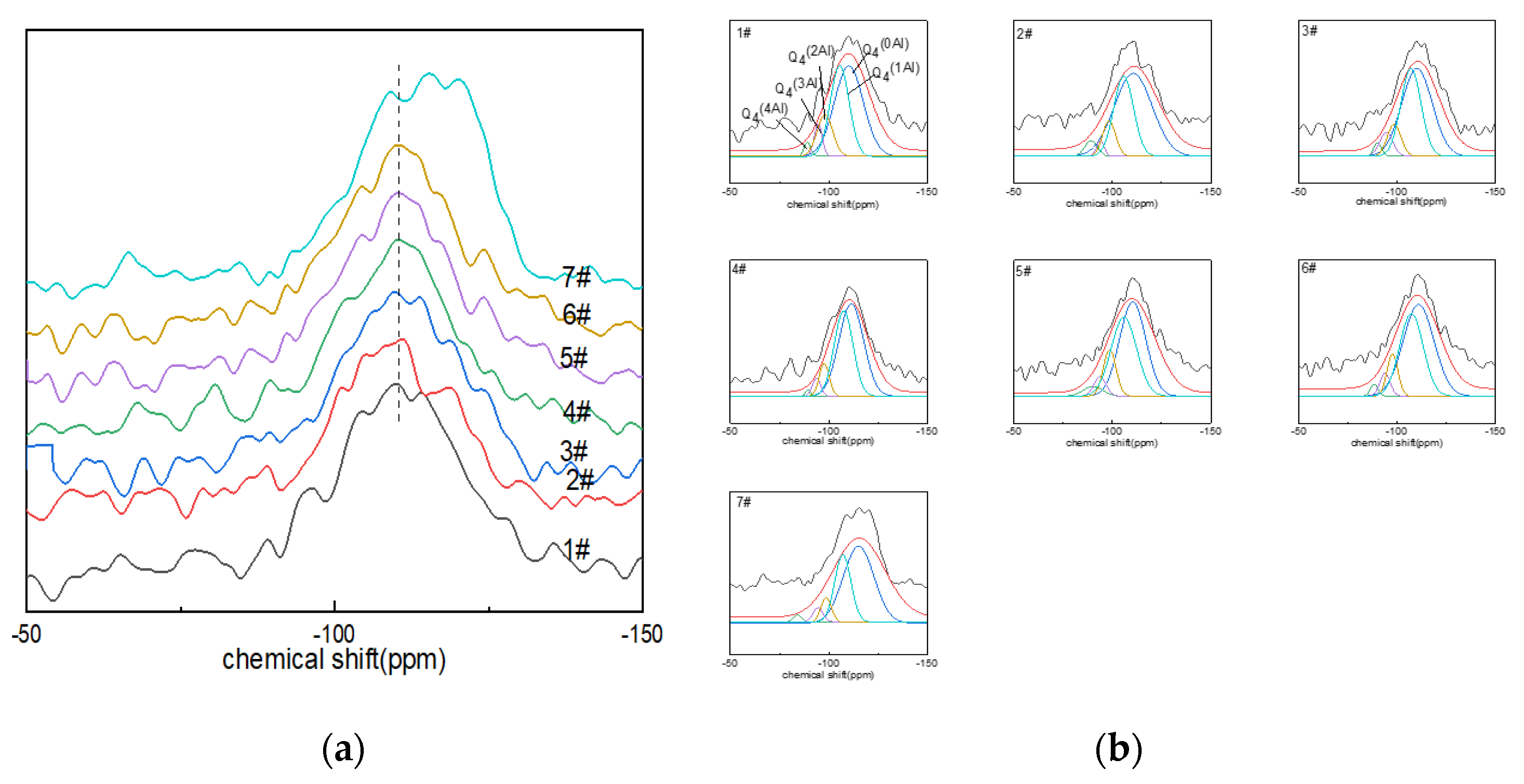
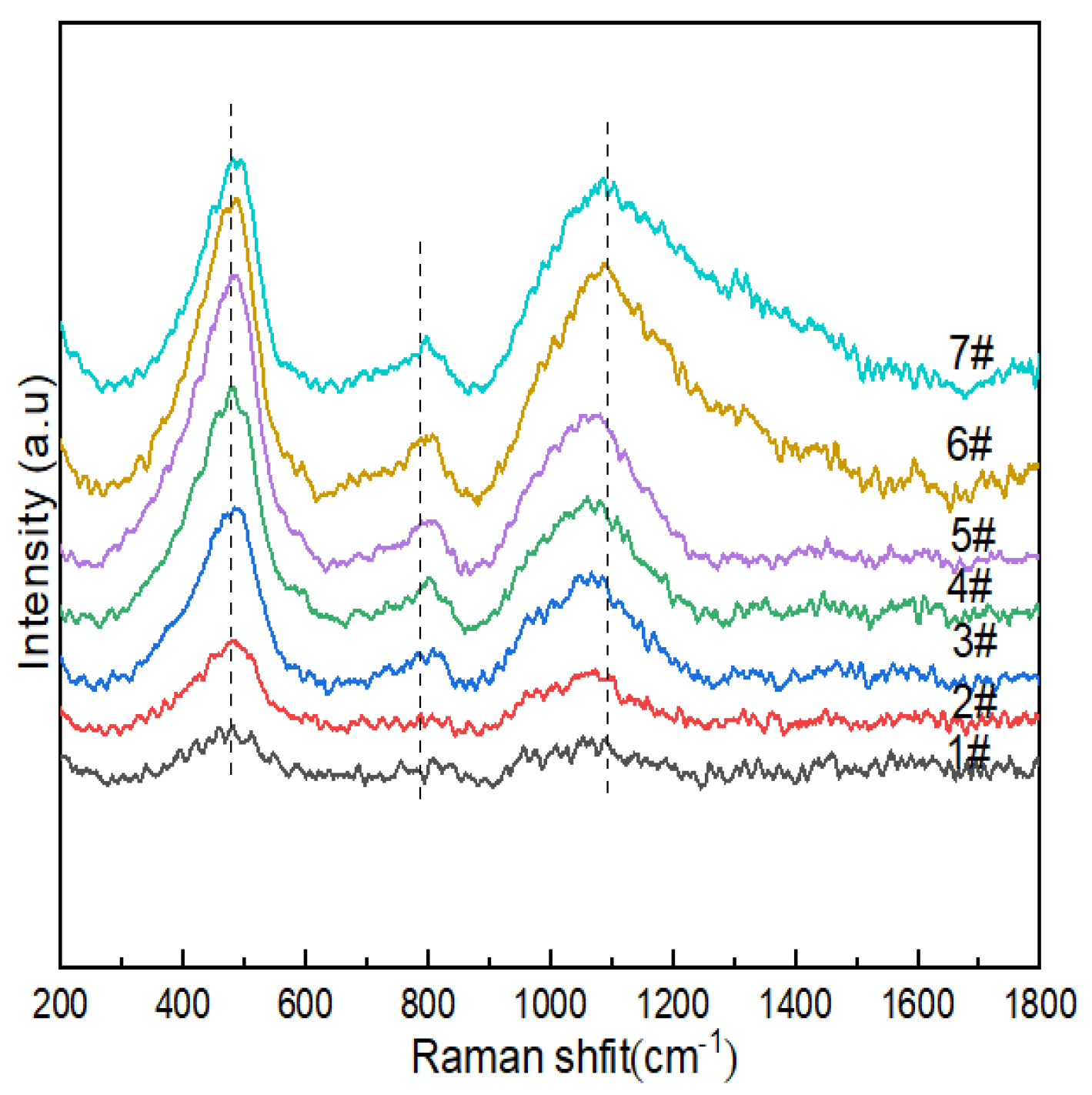
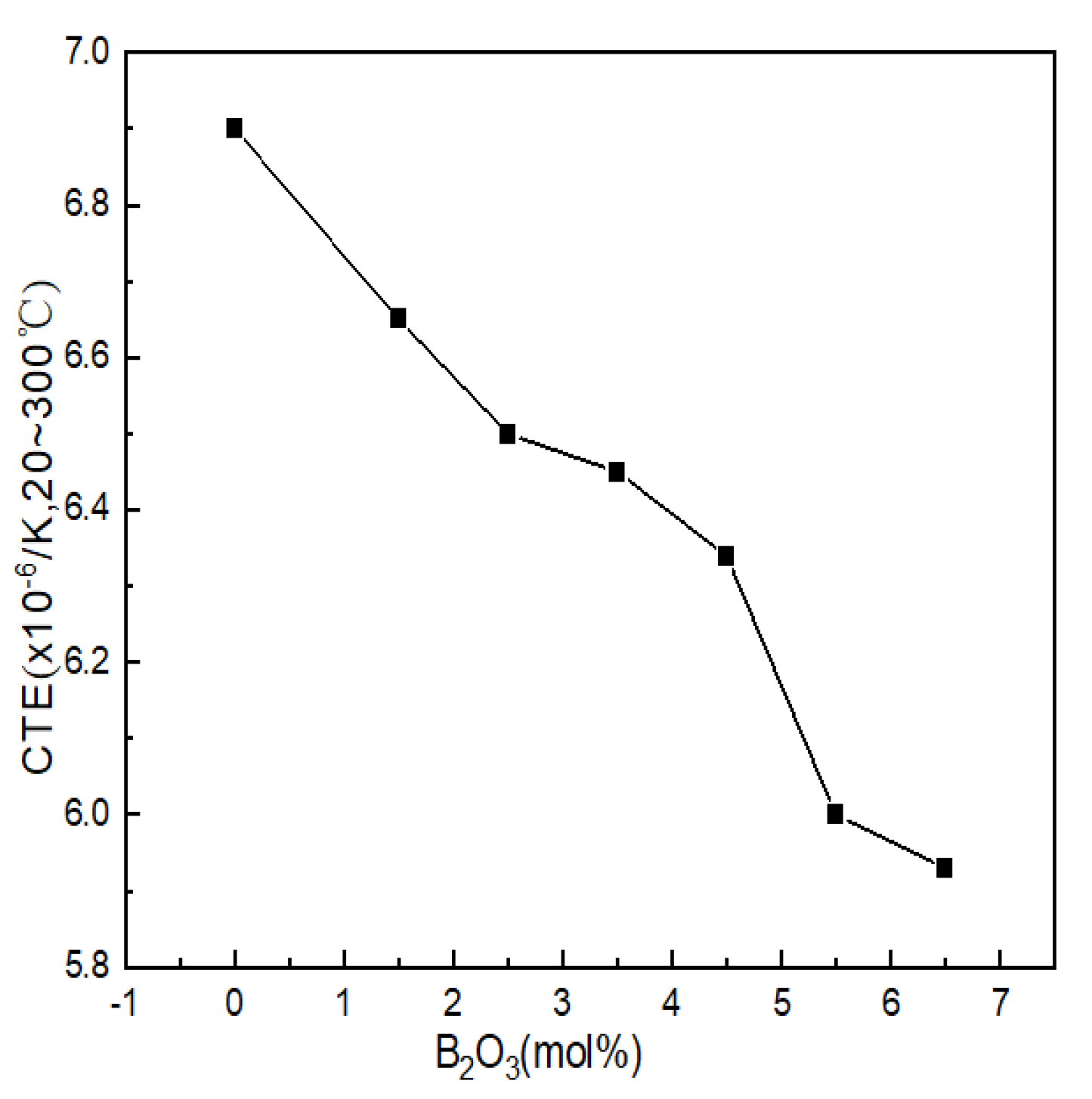
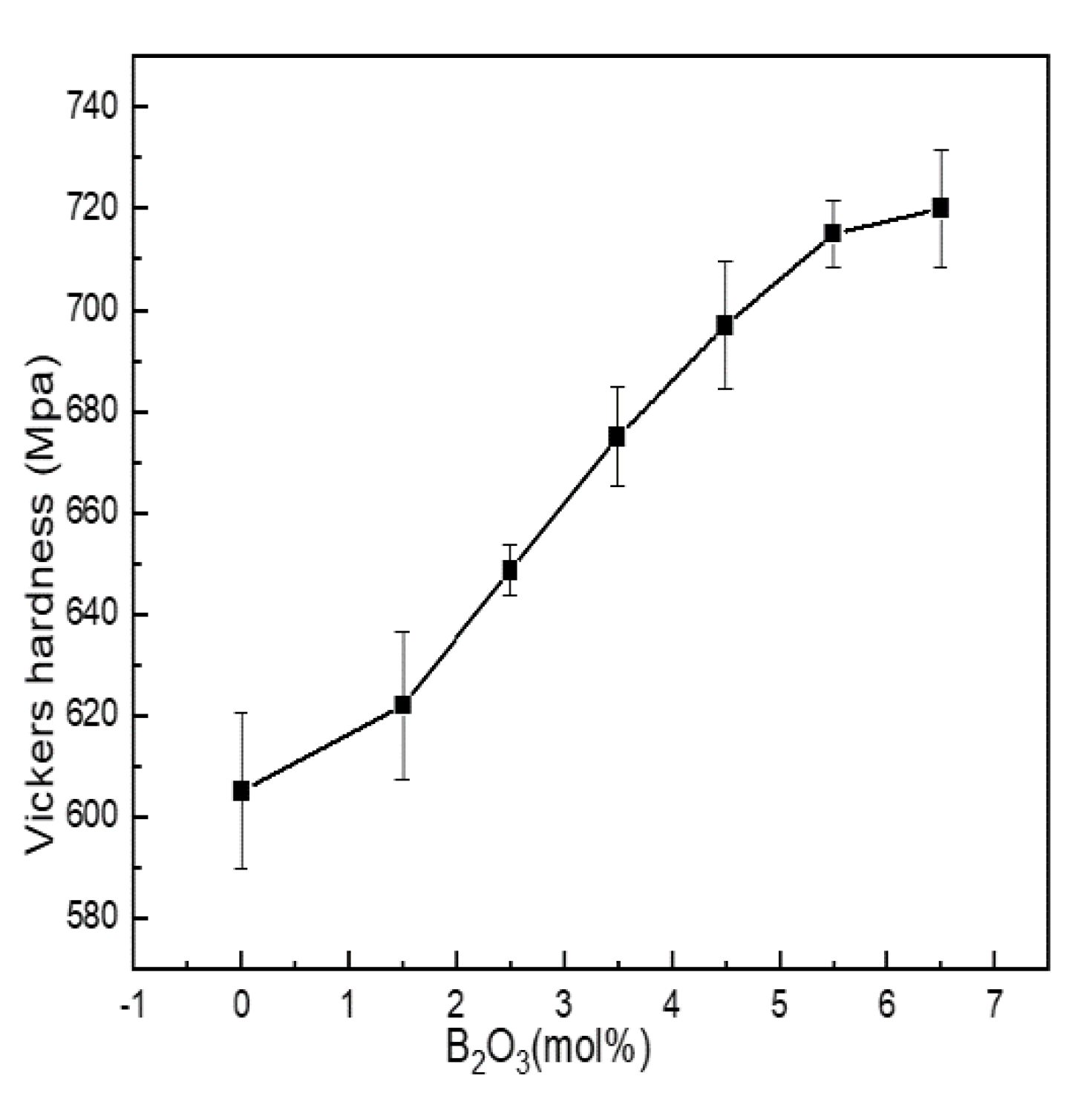
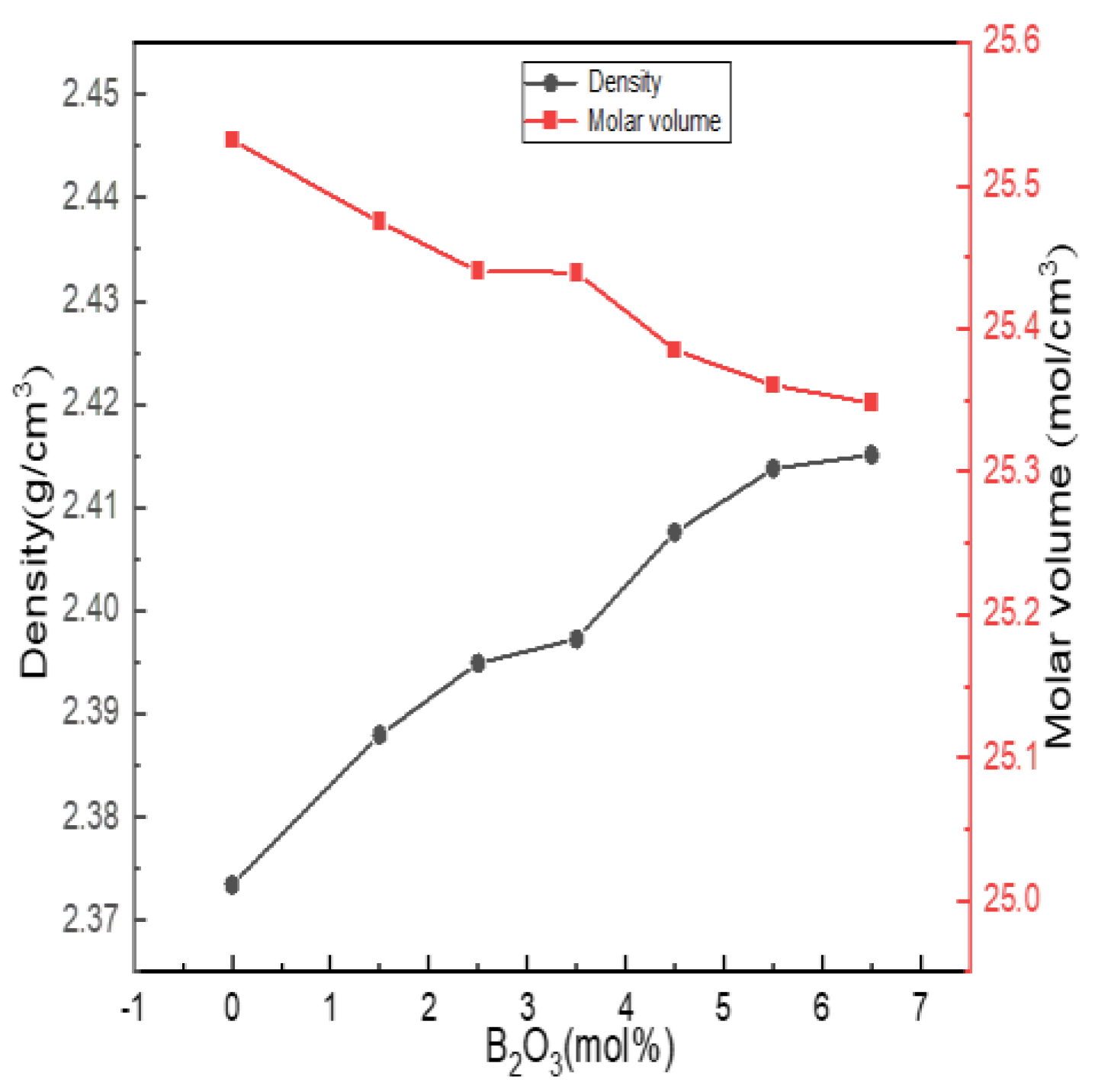
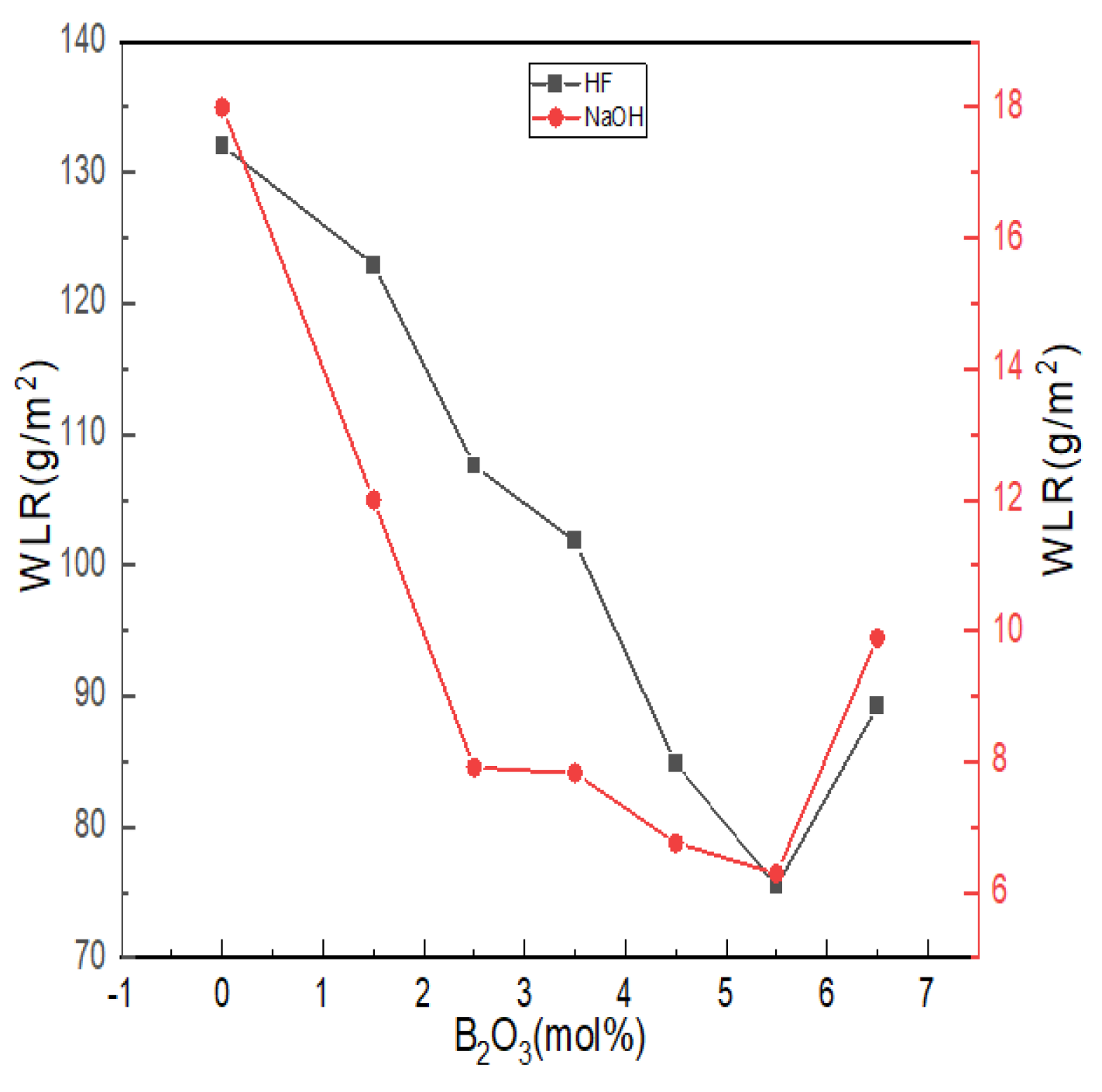
| Sample | 2# | 3# | 4# | 5# | 6# | 7# |
|---|---|---|---|---|---|---|
| Nominal ratio (%) | 1.72 | 2.86 | 4 | 5.14 | 6.28 | 7.4 |
| Proportion before melting (%) | 1.93 | 3.20 | 4.48 | 5.76 | 7.03 | 8.29 |
| Measured proportion after melting (%) | 1.76 | 3.00 | 4.31 | 5.44 | 6.87 | 8.01 |
| Volatility (%) | 8.81 | 6.25 | 3.79 | 5.56 | 2.28 | 3.38 |
| Sample | AlIV | AlV | AlVI | |
|---|---|---|---|---|
| 1 | Position (±0.2 ppm) | 42.6 | 24.6 | 2.6 |
| Area (±3%) | 73.0 | 20.2 | 6.8 | |
| 2 | Position (±0.2 ppm) | 41.7 | 23.9 | 4.0 |
| Area (±3%) | 74.1 | 19.0 | 6.9 | |
| 3 | Position (±0.2 ppm) | 42.0 | 23.0 | 2.8 |
| Area (±3%) | 74.8 | 18.7 | 6.5 | |
| 4 | Position (±0.2 ppm) | 42.9 | 24.1 | 3.7 |
| Area (±3%) | 75.3 | 18.3 | 6.3 | |
| 5 | Position (±0.2 ppm) | 43.0 | 26.0 | 5.4 |
| Area (±3%) | 75.6 | 16.8 | 7.6 | |
| 6 | Position (±0.2 ppm) | 42.6 | 25.1 | 4.2 |
| Area (±3%) | 73.4 | 20.2 | 6.4 | |
| 7 | Position (±0.2 ppm) | 42.6 | 25.3 | 5.4 |
| Area (±3%) | 69.0 | 23.5 | 7.5 |
| Sample | N4 | N3 | BIV-3Si | BIV-2Si | |
|---|---|---|---|---|---|
| 2 | Position (±0.2 ppm) | −0.1 | 9.3 | 0.4 | 2.0 |
| Area (±3%) | 50.2 | 49.8 | 65.0 | 35.0 | |
| 3 | Position (±0.2 ppm) | −0.1 | 9.4 | 0.3 | 2.5 |
| Area (±3%) | 52.6 | 47.4 | 58.6 | 41.4 | |
| 4 | Position (±0.2 ppm) | −0.3 | 9.7 | 0.2 | 1.8 |
| Area (±3%) | 54.4 | 45.6 | 63.2 | 36.8 | |
| 5 | Position (±0.2 ppm) | 0.1 | 9.6 | 0.5 | 1.7 |
| Area (±3%) | 55.8 | 44.2 | 62.5 | 37.5 | |
| 6 | Position (±0.2 ppm) | 0 | 9.8 | 0.4 | 2.0 |
| Area (±3%) | 59.9 | 40.1 | 65.9 | 34.1 | |
| 7 | Position (±0.2 ppm) | 0 | 8.7 | 0.5 | 2.0 |
| Area (±3%) | 58.0 | 42.0 | 60.9 | 39.1 |
| Sample | Q4(0Al) | Q4(1Al) | Q4(2Al) | Q4(3Al) | Q4(4Al) | |
|---|---|---|---|---|---|---|
| 1 | Position (±0.2 ppm) | −108.9 | −104.5 | −97.6 | −94.9 | −88.3 |
| Area (±3%) | 39.9 | 46.4 | 8.2 | 3.9 | 1.6 | |
| 2 | Position (±0.2 ppm) | −109.8 | −104.8 | −97.8 | −92.7 | −88.3 |
| Area (±3%) | 44.9 | 36.7 | 10.7 | 4.3 | 3.4 | |
| 3 | Position (±0.2 ppm) | −110.6 | −106.4 | −97.8 | −93.6 | −90.8 |
| Area (±3%) | 48.9 | 32.3 | 12.2 | 4.9 | 1.7 | |
| 4 | Position (±0.2 ppm) | −111.0 | −107.7 | −97.0 | −93.4 | −89.0 |
| Area (±3%) | 50.5 | 33.3 | 8.3 | 6.0 | 1.9 | |
| 5 | Position (±0.2 ppm) | −109.8 | −105.0 | −98.9 | −94.3 | −89.5 |
| Area (±3%) | 52.0 | 36.5 | 7.4 | 3.4 | 0.7 | |
| 6 | Position (±0.2 ppm) | −110.0 | −107.2 | −96.8 | −94.1 | −87.8 |
| Area (±3%) | 53.7 | 32.0 | 8.3 | 4.3 | 1.7 | |
| 7 | Position (±0.2 ppm) | −114.4 | −106.2 | −97.8 | −93.9 | −83.5 |
| Area (±3%) | 51.2 | 36.7 | 6.9 | 3.6 | 1.6 |
| Peak Position/cm−1 | Assignment |
|---|---|
| ~480 cm−1 | Si–O–Si bending vibration in [SiO4] without non-bridging oxygen in glass network structure |
| ~760cm−1 | Stretching vibration of Si–O–Al between [SiO4] and [AlO4] |
| ~770 cm−1 | Symmetrical breathing vibrations of the [BO4] group |
| ~803cm−1 | Boroxol ring breathing mode of the [BO3] group |
| Stretching vibration of Si-O bonds in silicon–oxygen tetrahedron [SiO4] |
Publisher’s Note: MDPI stays neutral with regard to jurisdictional claims in published maps and institutional affiliations. |
© 2022 by the authors. Licensee MDPI, Basel, Switzerland. This article is an open access article distributed under the terms and conditions of the Creative Commons Attribution (CC BY) license (https://creativecommons.org/licenses/by/4.0/).
Share and Cite
Huang, S.; Wang, W.; Jiang, H.; Zhao, H.; Ma, Y. Network Structure and Properties of Lithium Aluminosilicate Glass. Materials 2022, 15, 4555. https://doi.org/10.3390/ma15134555
Huang S, Wang W, Jiang H, Zhao H, Ma Y. Network Structure and Properties of Lithium Aluminosilicate Glass. Materials. 2022; 15(13):4555. https://doi.org/10.3390/ma15134555
Chicago/Turabian StyleHuang, Shoujia, Wenzhi Wang, Hong Jiang, Huifeng Zhao, and Yanping Ma. 2022. "Network Structure and Properties of Lithium Aluminosilicate Glass" Materials 15, no. 13: 4555. https://doi.org/10.3390/ma15134555
APA StyleHuang, S., Wang, W., Jiang, H., Zhao, H., & Ma, Y. (2022). Network Structure and Properties of Lithium Aluminosilicate Glass. Materials, 15(13), 4555. https://doi.org/10.3390/ma15134555






